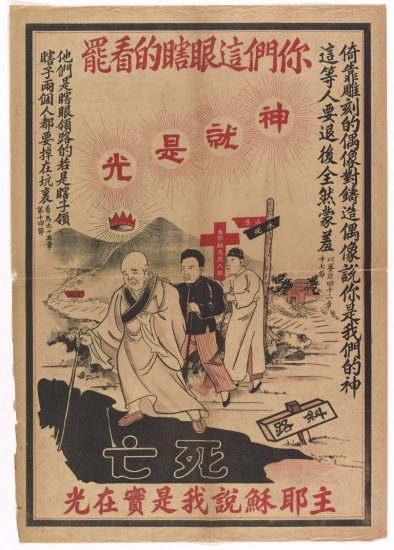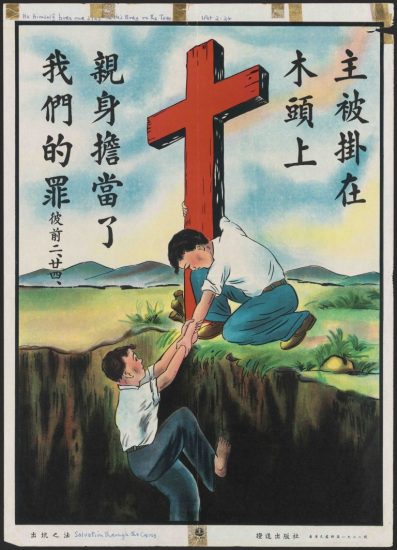


“Look, You Blind!” (Date and Publisher Unknown)
In this poster we see two men following behind an older man who is about to walk off of a cliff ledge. The poster features a great deal of color contrast between red and black, with black being an arguable “threatening” foil to the red depiction of Christ as exemplified through the cross. The biblical quotes and religious messages speak of blindness and God as a light, which calls attention to the older man’s inability to see what doom he’s walking towards. The poster deals in paths with there being a path to salvation and a path to eternal death as noted by the signposts; this is a clear allusion to the potential to end up in Heaven or Hell.
Aspects of the May Fourth Movement can be seen if we ask what semblance, if any, age plays here. Potentially, we see the younger generation being led astray by the older man who is closest to the cliff ledge. This can be related to the May Fourth Movement where student demonstrators strongly criticized traditional Chinese values and by extension, how the older generation was damaging China. The left border quotes Matthew 15:14 and reads: “They are blind guides. If the blind lead the blind, both will fall into a pit.” The individuals’ blindness is represented through their use of canes, which would be helpful for illiterate viewers, but related to previous commentary, we see a similar criticism of weak leadership.
This poster, like many in the archives, makes use of cliffs as a sign of danger. The crown is a unique symbol in the distance; I didn’t note any other posters that made such enigmatic use of a crown for symbolic purposes and I’m still unsure of the meaning behind its placement. Overall though, even without reading ability or cultural context I think one would be able to make sense of what’s going on, provided they’re at least familiar with the cross as a religious symbol.
“Salvation Through the Cross” (Christian Witness Press, Date Unknown)
Here we have a young man helping a similarly aged figure up from a fall into a deep pit. Of note, the man with the higher ground is using a red-colored cross to support their combined weight. This recalls the common motif for a Christian believer to allow Christ to carry their burden in times of need. Through clothing, we get the impression that the two figures are schoolboys or young workmen; regardless, they are dressed favorable and appear to be of a respectable class.
The imagery, like many of the archival posters, plays off of the politics of respectability or religious prosperity. Though left unsaid, one might be left with the lurking suspicion that Chinese evangelists are pandering to a middle-class demographic or at least those with aspirations to the middle class. The press’ other poster included here, “Bridge of Salvation,” seems to similarly support this aspect in a subdued manner. In contrast, another poster from the Christian Witness Press archive, “Become a New Creation,” much more explicitly promotes a vision of prosperity operating in relation to religious belief and practice.
There is a lone biblical quote: “He himself born our sins in his body on the tree.” This quote can be appreciated along with the image, because the cross is bearing the weight of the lower-situated man’s attempt to climb up from the fall. The poster is effective, with or without the quote, but because the text compliments the image, it gives viewers a better sense of the meaning behind what’s being taught.
“Bridge of Salvation” (Christian Witness Press, Date Unknown)
This poster features a clear gorge and the cliff is differentiated from the previous two posters, because the other side of the divide is illustrated. Consequently, the dynamics have changed and the pass is something to be crossed rather than avoided. Because of the presence of an active challenge, so to speak, the men are granted more agency to handle the issue. If one is able to read the text, they’ll learn what tools are being employed to overcome the problem: “Good works,” “Merits and Virtues,” and “Religion.”
This poster is more didactic in that some Christian virtues are being instructively relayed outside of the simple issuing of biblical verses.The verses pull from Romans, Acts, John, Titus, and 1 Corinthians. Of interest, Titus 3:5 reads: “But-He saved us, not because of righteous things we had done, but because of his mercy.” One might question how this verse aligns itself with the overall message of the poster, which seems to be promoting the benefits of deeds and positive activity. Of course, these qualities may ultimately spring from God, but this verse still seems out of place.
The sheer pervasiveness of text aligns this poster with “Look, You Blind!” rather than “Salvation Through the Cross,” which is interesting if only because we know that “Salvation” also comes from the Christian Witness Press; that does go to show how the Christian Witness Press had some variety to their methodology though. Without knowledge of what’s being said a viewer could still come away knowing that Christianity plays a role in tackling obstacles, because of the presence of the emblematic cross.
When going through the collection of evangelical works, there’s a repeated presence of dangerous cliffs in poster imagery, regardless of poster creator. Within Christian teachings it has always been important to stress the importance of protecting one’s soul; believers have been influenced to fear death, unless they were already categorically “saved.” With this in mind, one question I had was – why cliffs? There are many ways in which one might meet their end and falling off of a cliff is far from the leading cause across time. Looking to the first poster, the danger of cliffs signals a lack of vision or awareness. To fall from a cliff, one may not have been walking with their eyes open. In another way, the act of falling signals the inevitability of gravity; more gravely, it might signal the inevitable “fall” to sin. Of note, posters two and three show ways to avoid these dangers. With poster two we see a young man, assisted by the cross, helping another fellow up from a cliff fall. Poster three shows business men literally bridging their way across the precarious cliff. Both posters, in contrast to the first poster, show how humans are able to use the power of faith and good deeds to avoid earthly pitfalls. My initial question about the cliff as imagery along with the subsequent explanations speaks to Joseph Ho’s notion that “images provide spaces in which historical questions may be answered or generated, memories and perceptions constructed or deconstructed” (57).
We also see a repeated use of the color red, but color symbolism can stand for many things. Since the color is used for each poster’s representation of the cross, its safe to assume that the color is representative of God or Christianity itself. There are other posters on the website archive (“Become a New Creation,” “By His Wounds We Are Healed”) that continue to use red in representations of the cross, so its a consistent pattern. One interesting, though ambiguous, repetition is the use of red for clothing articles. We see red used in poster one for pants and shoes; for poster three we see red used for a man’s tie. Because red is used in depictions of the cross you might think that illustrators would shy away from painting with this color on other articles, especially those actively worn by humans, but we see red used on clothing in other archive posters (“Come,” “Entering Into Salvation,” “Flee For Your Life”). Arguably, the prevalence of red destabilizes the color’s impact in depictions of the cross, so the various illustrator’s choices here are very curious, to say the least. When Joseph Ho speaks on “complexities in the broader foreign missions projects… connected to a ‘crisis of identity’ that American foreign missionaries wrestled with” (45) it’s possible that this issue of color is one such “crisis of identity.”
Seeing these posters for the first time, ignoring the translated characters and descriptors, I would have a number of questions. For one, I would question why it appears that an old man is about to walk himself into a clear hole, as is shown in the first poster. I would ask myself if the two men behind him are more aware of the fault the man is about to make. I would question the semblance of the red crown shining off beyond the hills in the background. For the second poster I might question how the young man had ended up in the hole in the first place, why does he need assistance to climb out? I might question what a very sturdy cross is doing right next to this pit fall and how the man with higher ground came into “contact” with it. What differentiates him from the other young man and allows him to wield the cross for stability? For the third poster I’d question why the three men are wielding bridges with characters on them. Obviously bridges serve a purpose, but what purpose do the characters serve? In what way are characters or written messages able to become “bridges?” I’d also question why they don’t all just use the stone bridge that is visible on the right side of the poster. One thing worth noting is that all three posters are visual as well as textual; they have biblical quotes and religious messages that one must be able to read to get the full content of what’s being communicated. The visuals work to some degree by themselves, but reading ability is necessary to get the full story.
